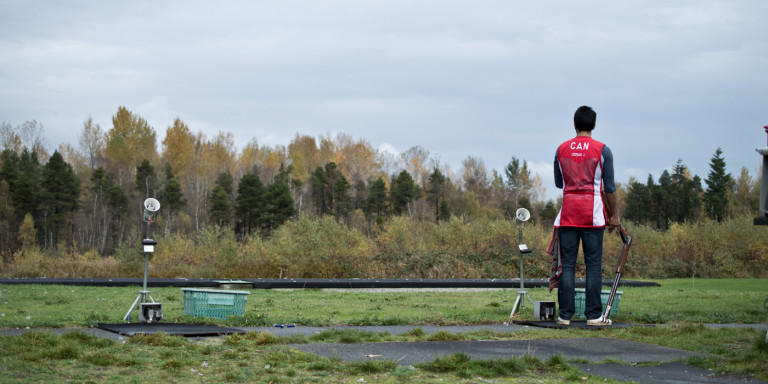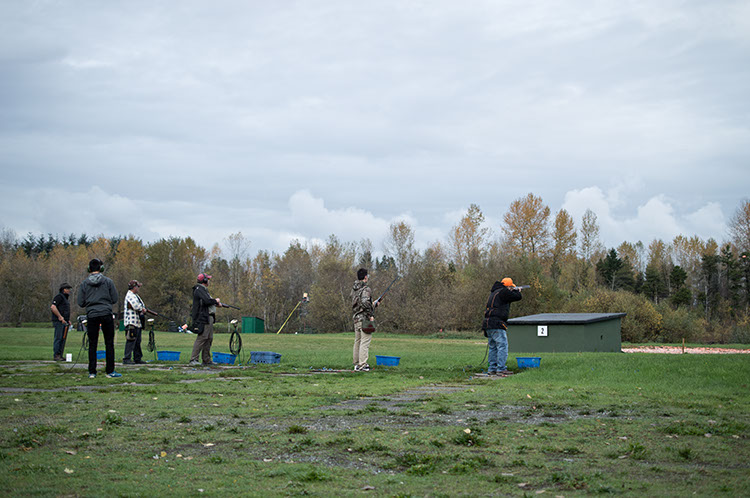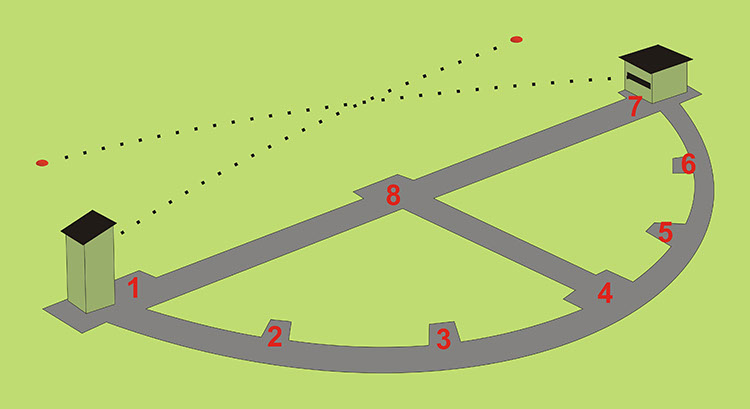
Few of the shooting sports are as easily approached as those involving the venerable shotgun. While things like IPSC, 3-Gun, or even long-range marksman competition require multiple firearms, expensive gear, or additional certifications to participate, the ever-present and ever-popular shooting sports of trap, skeet, and sporting clays and their various derivatives require little more than a cheap single-shot or pump-action shotgun and a willingness to learn. Here's a crash course on the clay games.
By far the most popular of the clay shooting sports, trap has been around for literally hundreds of years, with some evidence of its inception dating all the way back to 1750. Initially, the game used live birds released from underneath hats, before transitioning to glass balls thrown in the air by hand around 1860. By just 1880 those too were replaced by early forms of the clay discs currently used, and by 1909 the automatic target thrower had been invented, giving rise to the game as it is shot today.

The throwing machine oscillates left to right through anywhere from 34 to 54 degrees, or 17 to 27 degrees off-centre. The targets typically travel anywhere from 48 to 52 yards total, but must rise to be between 8 and 12 feet above the ground at the ten yard mark. This typically means the target is moving at roughly 65 kilometers per hour. The variations in distance can be accredited to winds or even atmospheric pressure changes. This brings us to the key component identifying trap, in all its various forms: The target are generally shot on the rise and always travel away from the shooters.

Etiquette: Trap is a formal game, one which respects rhythm, and demands consistency. Loading more than one shell, moving around excessively, calling for targets in a "vulgar" or otherwise distracting manner will earn you black marks.
Tip: For first time trap shooters, concentrate and practice a consistent gun mount, and begin by placing the bead of the shotgun on or slightly above the top edge of the trap house ahead when calling for the target. Continue to sweep the muzzle through the clay as you squeeze the trigger to ensure a clean follow through.

Skeet is slightly more complex than trap, with twice as many target throwers, more shooting stations, and more targets. Comparably much newer than trap, it was created in the 1920s by Charles Davis; an avid grouse hunter living in Andover, Massachusetts. Initially called "Clock Shooting," the game first involved a circular array of shooting stations arranged like a clock face around a 50 yard diameter, with a single throwing machine positioned at the 12-o'clock position to throw targets in any direction. However when a chicken farm moved in next door, Davis had to modify his game to restrict the shooting directions, which led to the installation of a second throwing machine at the 6-o'clock position and a halving of the shooting positions.

Like trap, the game consists of squads of no more than five shooters, with 25 targets per participant. Also like trap, only one participant shoots at a time, so all guns remain open and unloaded until an individual is ready to call for a target. However, unlike trap, the squad moves through each shooting station together. In other words, all participants take their turns shooting from station one, before the entire squad progresses to station two, and so on and so on.


Tip: On station one, ignore the skeet house and concentrate on where the shot will be taken, because if you're thinking about where the throwing machine is you'll end up with a gun pointed too high, and the target will disappear behind the barrel as you chase it down.
Other versions to try: Olympic skeet. Like Olympic trap, Olympic skeet uses targets that move faster than conventional skeet targets, and are released at a random interval after the target has been called for. Compounding that, shooters must also call for the target from a low-ready position, with the toe of the stock close to the hip.
The third, and by far most diverse of the shotgun disciplines is the family of shooting sports known as sporting clays. Intended to most closely simulate hunting excursions and sometimes referred to as "golf with a shotgun," sporting clays may be the newest of the shotgun games, but has managed to become one of the most popular in the roughly 30 years since it was introduced in America.

The typical sporting clays round involves, as with so many other shotgun games, squads of shooters walking the course and shooting the round together. Periodically positioned along the course, the shooting stations frequently take the form of an empty door frame, and each shooter steps up the station, loads no more than two shells and calls for their target.
In sporting clays, the targets at any given station may be thrown in one of four ways; singles, a true pair, a following pair, or on report. Singles are obviously thrown one at a time, while a true pair is thrown simultaneously. A following pair is a pair of targets thrown in succession, with a slight delay between the two, while a pair "on report" consists of a single target thrown followed by a second thrown when the first shot is taken. In this manner, each shooter will have five opportunities to engage the target sequence at each individual stage, meaning anywhere from five to 10 rounds of ammunition will be used per station.

Sporting clays courses also use specialized sporting clays targets. These include midi- and mini-size targets, as well as battues and rabbits. Midi targets are roughly 2/3 the size of a standard target, and mini targets being roughly half the size of a standard target, making both of them not only harder to connect with but also harder to hit due to the higher speeds at which they are thrown. Battues are not concave targets like the others, and are simple flat discs roughly the same size as a standard target, which means they do not have any degree of "float" to their flight nor do they slow down as much as the less aerodynamic domed target. They come off the thrower hard and fast and sometimes disappear into the foliage before you can even get a clear view of it. The final specialized sporting clay target, and one of the most enjoyed, is the rabbit. Flat like a battue and roughly the same size, the rabbit is a heavier-weight target that is thrown by the machine in an underhand fashion, so that it rolls on edge across the ground. Of course, the ground in question is never totally flat, so these targets usually carom unpredictably off any slight imperfection on the ground.
Etiquette: Sporting clays is the least formal of the shotgun sports, and part of that "golf with guns" mentality comes from the easy, social atmosphere that pervades most courses. Expect lots of conversation to spice up the experience.
Tip: On springing teal targets, do not be overeager, and instead look to take your shot at they reach their zenith, as that is when they're moving slowest. On rabbits try and shoot the bottom edge off the clay, as it'll keep the target in sight and, due to the fact that most sporting shotguns throw 60% of their pattern above the point of aim, will keep more pellets on target.
